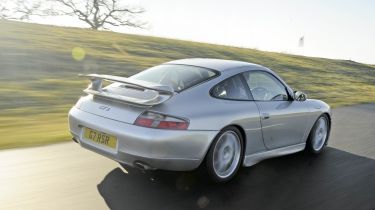Porsche 996 GT3
Stripped-out cabin and unique badging hint at potential of GT3’s all-new flat-six – which was based on unit from GT1 racer.
A 911 with a water-cooled engine? The very idea of the 996 caused many enthusiasts to get hot under the collar. Could a true 911 really do without air cooling? The answer was yes, and one particular 996 stands out as a great: the GT3.
Launched at the Geneva Motor Show in 1999, it was conceived as the modern day incarnation of the 2.7 RS. And as with its 1973 predecessor, it was built to homologate the 911 for racing.
What made it special was its engine. Sitting below the shapely rear wing wasn’t a tuned version of the standard 3.4-litre flat-six, but an all-new 3.6-litre unit based on the turbo from the firm’s GT1 supercar.
Porsche re-engineered the hand-built engine for mass production, dispensing with the turbos but keeping the titanium con rods. This allowed it to rev much higher than the standard unit, adding huge credibility to the GT3’s performance car appeal.
At launch, the 360bhp GT3 was the most powerful normally aspirated 911 ever sold to the public. The use of race-inspired parts wasn’t limited to the engine, either. The six-speed manual gearbox was taken from the rare 993 GT2, while a lower ride height, adjustable dampers, firmer springs and reworked anti-roll bars meant the chassis had equal pedigree. Upgraded brakes and lightweight 18-inch wheels completed the dynamic improvements, and a deep chin spoiler, wider sills and double-deck rear wing ensured there was no mistaking the GT3.
Used - available now

2020 Jaguar
F-Pace
31,770 milesAutomaticDiesel3.0L
Cash £25,890
2024 Peugeot
5008
40,906 milesAutomaticDiesel1.5L
Cash £20,197
2023 Ford
Focus
14,538 milesManualPetrol1.0L
Cash £17,087
2023 Jaguar
E-PACE
20,181 milesAutomaticDiesel2.0L
Cash £24,287Needless to say, it had the performance to match its looks. The 0-60mph sprint took 4.7 seconds, while top speed was 187mph. Even more impressively, the GT3 was the first production model to lap Germany’s Nürburgring circuit in less than eight minutes. Plus, in its first-ever race, the competition version won its class in the 1999 Le Mans 24 Hours.
Road models came in two trims: Comfort or Clubsport. Our car is one of the latter, and is designed to be even more track focused. It gets a roll cage, fire extinguisher, bucket seats and single-mass flywheel, which makes a unique rattling noise when you press the clutch at a standstill. All this adds to the sense that the GT3 was in keeping with the finest traditions of Porsche – a road car derived from competition.
The power and torque of the 3.6-litre engine, combined with the precise chassis and the superb brakes, mean it’s one of the most engaging driver’s cars of its era. Its success led to a second-generation 996 GT3, the 996 GT3 RS, as well as the subsequent 997 versions. That’s an outstanding bloodline.
Owner profile by Alexander Drobik
GT3 owner Alex has been driving Porsches since 1979. “Seeing them compete in the Le Mans 24 Hours was the inspiration for me to buy my first one,” he tells us.
“I’ve always loved Porsche’s racing heritage; it breeds speed and reliability. That’s what made the Clubsport-spec GT3 so incredibly appealing to me. It’s a racing car for the road; the engine is wonderfully responsive and high
revving. I use it for track days and on the road. It’s a very special 911.”







